Appeal Process: A Step-By-Step Guide to Challenging Court Decisions
Updated On: October 23, 2025 by Aaron Connolly
Understanding the Appeal Process
The appeal process gives you a way to challenge a court decision if you think the judge made a legal mistake. Instead of re-examining evidence, appeals focus on legal errors and follow strict rules and deadlines that can be pretty different from what happens in a regular trial.
Definition of an Appeal
An appeal is when you ask a higher court to review and possibly overturn a lower court’s decision. By filing an appeal, you’re really just asking, “Did the court mess up legally?”
Appeals aren’t new trials. You can’t bring in new evidence or surprise witnesses. Appellate courts go over the existing records, transcripts, and all the legal paperwork from your original case.
For an appeal, you’ll need to:
- File within a tight deadline (usually 28-42 days)
- Point out specific legal errors
- Show how those mistakes affected the result
- Pay any court fees that apply
The person who files the appeal is the “appellant.” The other side is the “respondent” or “appellee.”
Purpose of the Appeal Process
Appeals act as a safety net in the legal system. They help make sure legal mistakes don’t lead to unfair results and keep court decisions consistent.
The main goals are:
- Fixing legal errors made by trial judges
- Making sure laws and rules are applied fairly
- Protecting your rights if something went wrong with procedures
- Helping set legal precedents for future cases
You don’t get a guaranteed win on appeal. You have to show that a real legal mistake happened and that it probably changed your case’s outcome.
Most successful appeals point to clear procedural problems, wrong interpretations of the law, or times when judges went beyond their authority. Just not liking the verdict isn’t enough to appeal.
Key Differences from a Trial
Appeals work in a totally different way than trials. Knowing what sets them apart can help you keep your expectations realistic.
Evidence and testimony:
- You can’t bring in new evidence or witnesses
- There’s no jury
- Judges read written documents and legal briefs
- Oral arguments are all about how the law was applied
Timeline and procedures:
- Appeals can take months, sometimes years
- Deadlines are strict and usually can’t be extended
- Written briefs have to follow set formatting rules
- You might only get a short time to argue your case in person
Decision-making process: Appeals courts can agree with the original decision, overturn it, or send it back for another look. They only care about whether the right legal steps were followed—not whether they agree with the facts.
Right to Appeal and Eligibility
Knowing your right to appeal means you can push back on decisions that impact your benefits or services. Most government programs and insurance plans have their own appeal processes, with specific timeframes and rules.
Who Can Appeal
Primary Applicants and Beneficiaries
If a decision directly affects you, you can appeal. This covers people who applied for benefits or services and got a decision they didn’t like.
Authorised Representatives
You can have someone else handle your appeal. That could be:
- A family member or friend
- A solicitor or advocate
- Someone else you trust
Your representative needs proper authorisation to speak for you. They can take care of communications and represent you through the whole process.
Employers and Organizations
Sometimes, employers can appeal decisions that affect their employees’ eligibility. This usually comes up with workplace insurance programs or employer-run benefits.
What Judgements Can Be Appealed
Eligibility Determinations
You can appeal decisions about whether you qualify for certain programs or benefits. Some common examples:
- Getting turned down for marketplace health insurance
- Denial of financial help or subsidies
- Medicaid or CHIP eligibility decisions, depending on your state
Coverage and Payment Decisions
You can appeal if you disagree with:
- What services are covered under fee-for-service plans
- Whether managed care plans approve your treatment
- Payment amounts or how benefits are calculated
- Enrollment periods or changes to your plan
Processing Issues
You can also challenge things like:
- Delays in processing your application
- Wrong start dates for coverage
- Not getting eligibility notices on time
Limitations and Restrictions
Time Limits
Most appeals need to be filed within 90 days of getting your eligibility notice. If you miss the deadline, you’ll have to explain why when you file your appeal.
Document Requirements
Before you appeal, send in any documents they ask for to verify your application. Sometimes, you’ll get an updated decision that fixes the problem without needing a formal appeal.
Geographic Restrictions
Where you live can change your appeal options.
- Federal marketplace states: Appeals go to the HHS Appeals Entity
- State marketplace states: Each state runs its own appeals
- Medicaid/CHIP appeals: Only available in certain states like Alabama, Alaska, Louisiana, Missouri, Montana, North Carolina, Virginia, West Virginia, and Wyoming
Constitutional Basis
Your right to appeal comes from constitutional due process protections. That’s what keeps things fair when the government makes decisions about your benefits or eligibility.
Parties Involved in an Appeal
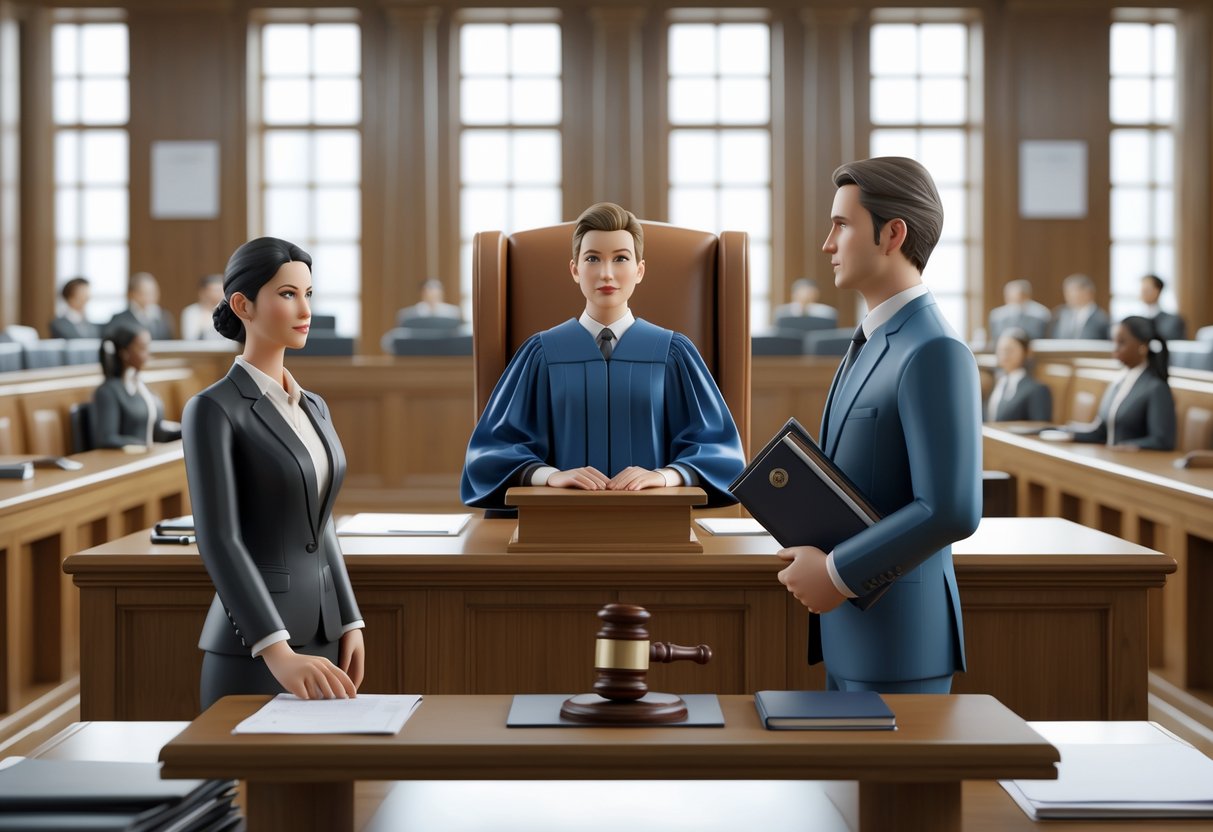
When you file an appeal, two main parties show up in the appellate court. The appellant challenges the original decision, while the appellee tries to defend it.
Appellant Explained
The appellant is the one who lost in the lower court and wants to challenge that ruling. They’re called the “moving party” because they kick off the appeal.
The appellant needs to:
- File the Notice of Appeal before the deadline
- Write legal briefs explaining why the lower court got it wrong
- Gather transcripts and evidence from the first trial
Appellants have to pay court fees and usually need legal representation because appellate rules are complicated. They have to prove the lower court made legal mistakes.
Most appellants are people, businesses, or organizations who aren’t happy with a jury verdict or a judge’s decision. Missing a deadline can end your appeal before it starts.
The appellant’s lawyer should point out specific legal mistakes, not just say they didn’t like the result.
Role of the Appellee
The appellee is the one who won in the lower court and now wants to keep that win. They answer the appellant’s arguments and try to persuade the appellate court to stick with the original decision.
The appellee’s main jobs are:
- File response briefs that push back on the appellant’s points
- Defend the lower court’s legal reasoning
- Point out any mistakes the appellant made in the appeal process
Appellees start with an advantage since they already won. Still, they need solid legal help to defend their position.
Usually, the appellee’s brief argues that the lower court did things right and got the correct result. Sometimes, they file cross-appeals if they want to challenge parts of the original decision too.
A smart appellee doesn’t just defend—they look for holes in the appellant’s case and poke at them.
Types of Appeals and Appellate Courts
The legal system includes different types of appellate courts, each with its own powers. Knowing these levels helps you see how cases move through appeals.
Levels of Appellate Courts
You’ll find three main levels of appellate courts. Each one reviews cases a bit differently.
Circuit Courts of Appeals are the first stop for federal appeals. There are 13 of them—12 cover different regions, and the Federal Circuit Court handles special cases from all over the country.
These courts review cases from the 94 district courts below them. They don’t hold new trials or hear witnesses. Instead, judges check if the lower court followed the right procedures and applied the law correctly.
State appellate courts handle state cases and work a lot like federal appellate courts. States use different names—some call them “Courts of Appeals,” others use “Superior Courts” or even “Supreme Courts.”
The U.S. Supreme Court sits at the very top. It gets over 7,000 requests each year but only hears about 100 to 150 cases. Most appeals end at the circuit court level.
Jurisdiction and Authority
Appellate court jurisdiction decides which cases a court can review and how. This authority changes depending on the court.
Federal appellate courts review cases involving federal law, constitutional issues, or disputes between states. They use specific standards to review lower court decisions. For factual findings, they only step in if there’s a clear error. For legal questions, they look at things more closely.
Geographic boundaries matter for appellate courts. Each circuit covers certain states or regions. You have to appeal to the circuit that covers where your trial court is.
The right to appeal isn’t automatic. In criminal cases, defendants usually get one appeal, but the government can’t appeal a not guilty verdict. Civil cases have their own rules about what decisions can be appealed.
Standards of review guide how appellate courts look at cases. They respect jury decisions about facts but look harder at how the law was applied. Constitutional questions get the closest review.
Steps to Initiating an Appeal
To start an appeal, you need to file certain paperwork, meet strict deadlines, and pay court fees. Most appeals start with a Notice of Appeal, and you’ll need to pay close attention to timing and costs.
Filing a Notice of Appeal
The Notice of Appeal is what you file to get your appeal going. This tells the court and the other party that you want to challenge the decision.
What you’ll include:
- Names of everyone involved
- The court and case number from the original case
- A short description of what you’re appealing
- Sometimes, your grounds for appeal
You have to file this notice in both the trial court and the appeals court. You’ll also need to serve a copy to the other party or their lawyer.
Key filing steps:
- Where: Trial court and appeals court (check your local rules)
- Who gets copies: The other side must get notice
- Certification: Many courts want proof you served the other party
The form is usually short and available on your court’s website. Some states have templates to make sure you include everything you need.
Deadlines and Time Limits
Appeal deadlines are strict—miss them and your case might be over before it begins. Each place sets its own time limits.
Most appeals have to be filed within 30 days of the final judgment. Some courts only give you 14 days; others allow up to 60. The deadline starts from the date the final order gets entered.
Timing tips:
- Weekends and holidays can sometimes extend deadlines
- Some courts want you to file by a certain time of day
- Extensions are rare and only happen in special situations
If you’re not sure about your deadline, call your local legal aid office or the court clerk right away. Courts almost never make exceptions for missed deadlines, even if you’re just a day late.
Heads up: Court holidays and closures usually don’t stop the deadline clock in most places.
Filing Fees and Fee Waivers
Appealing usually costs somewhere between £100 and £250. You have to pay this fee when you hand in your Notice of Appeal to the appeals court clerk.
Many courts let people apply for a fee waiver if they can’t afford it. You’ll need to fill out a financial statement showing your income, expenses, and assets.
Fee waiver requirements often include:
- Proof of benefits (like universal credit or housing benefit)
- Recent pay stubs or unemployment documents
- Bank statements
- Details about monthly expenses
You should file your fee waiver application at the same time as your Notice of Appeal. Some courts get to these requests fast, but others can take weeks.
Quick tip: Call the appeals court clerk’s office before you file your appeal. Ask them about their fee waiver forms and what counts as low income.
Essential Appeal Documents
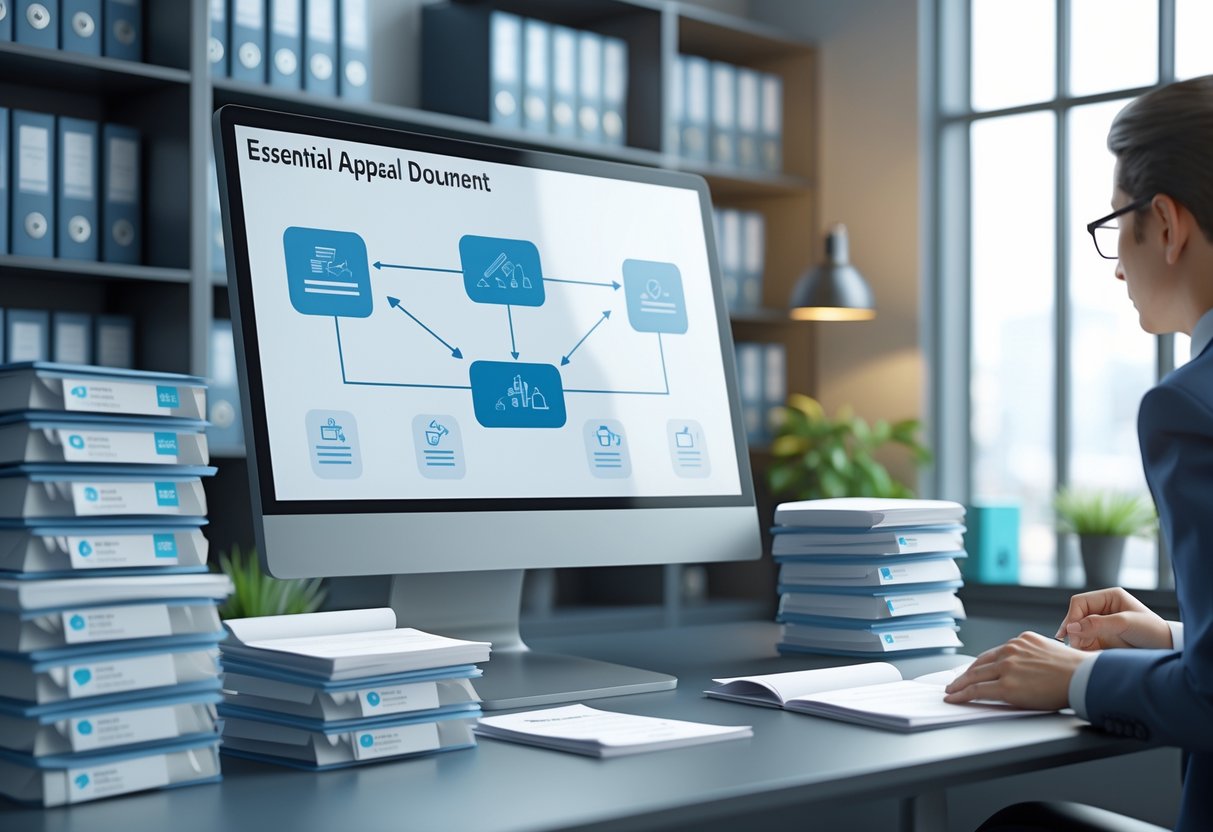
Getting your paperwork in order really makes or breaks an appeal. Courts want specific documents, and you’ll need to round up everything from your original trial.
Appellate Brief Requirements
Your appellate brief is basically your main argument to the appeals court. It explains why the original decision was wrong and what you want changed.
Structure and Content
Put your sections in a specific order. Start with a statement of facts—what actually happened in your case. Then move on to your legal arguments and point out where the trial court messed up.
Most courts limit briefs to 30-50 pages. Use clear headings for each section. Bold your main legal points so judges can spot them quickly.
Required Elements
You need a table of contents and a table of authorities in every brief. List all the laws and cases you cite, and include page numbers for each.
Add a statement of jurisdiction that explains why this appeals court can hear your case. End with a clear request for what you want the court to do.
Filing Requirements
File the original brief plus several copies. Most courts want anywhere from three to seven copies, depending on their rules. Check if your court accepts electronic filing.
Pay the filing fee when you turn in your brief. Fees usually range from £100 to £500, depending on where you are and what your case is about.
Collecting Trial Court Records
The trial court record is everything that happened during your original case. Appeals courts need these to see what went wrong.
What Records Include
The record covers all pleadings from both sides. That means your original complaint, the defendant’s answer, and any motions filed.
Court transcripts show what witnesses said and what the judge decided. You can use either audio recordings or written transcripts for appeals.
Obtaining Your Records
Contact the court clerk where your trial happened. Ask for a complete copy of your case file. Most courts charge per page—usually 10-50 pence a sheet.
Order transcripts from the court reporter who handled your trial. Transcript costs vary a lot, from £2 to £10 per page. If you need them fast, rush orders cost more.
Organising Documentation
Make a chronological index of all documents. Number each item and include the date it was filed. This makes it easier for appeals courts to find what they need.
Separate exhibits from pleadings and transcripts. Use tabs or dividers to mark the sections. Appeals courts see tons of cases, so keeping things organised really helps.
Legal Representation and Appellate Lawyers
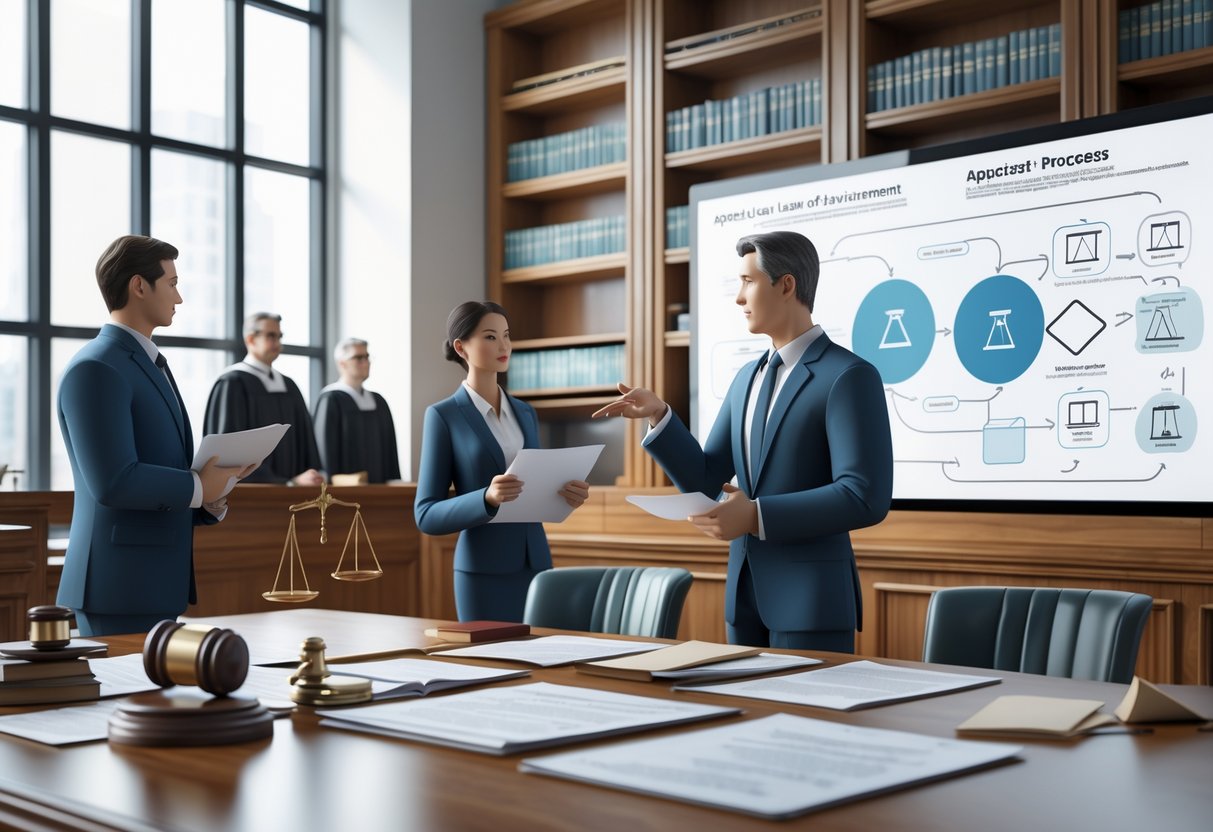
Appellate lawyers jump in after a trial court makes its decision. They focus on legal errors—not new evidence. You can represent yourself, but it’s tough.
Benefits of Hiring an Appellate Lawyer
Appellate lawyers bring a different set of skills than trial lawyers. They know the appeals process inside and out.
Key advantages include:
- Spotting legal errors in trial records
- Knowing all the deadlines and court rules
- Writing persuasive legal briefs
- Understanding case law and precedents
They build arguments based on the trial record. Appeals courts care about legal issues, not new facts.
Professional help matters because missing a deadline or filing the wrong paperwork can end your appeal before it starts.
Cost considerations:
- Appeals take a lot of legal research time
- You still have to pay filing fees and court costs
- Bad representation can waste money on a lost appeal
Most appellate lawyers offer consultations to review your case before you commit.
Self-Representation in Appeals
You can represent yourself in an appeal, but it’s not easy. Appeals courts have stricter rules and procedures than trial courts.
Main difficulties include:
- Tough legal research requirements
- Strict formatting for legal briefs
- Short deadlines you can’t miss
- Technical writing standards
You need to know appellate law to spot errors in your trial. That means understanding legal precedents and court procedures.
If you go it alone:
- Study your court’s appellate rules carefully
- Review successful appellate briefs for guidance
- Stick to legal arguments—don’t get emotional
- Meet every deadline, no exceptions
Some courts have self-help resources for people without lawyers. Still, self-represented appeals almost never do as well as those with lawyers.
Think about how complicated your case is and what’s at stake before deciding to handle it yourself.
Building Legal Arguments on Appeal

Winning on appeal means you need to find clear legal errors and back your arguments with the right case law. You have to dig into trial records to spot mistakes, then research precedents that support your side.
Identifying Legal Errors
Legal errors form the core of any strong appeal. These are mistakes in how the trial court applied the law—not just disagreements about facts.
The most common legal errors are things like bad jury instructions, letting in or excluding the wrong evidence, or applying the wrong legal standard. Sometimes, procedural errors matter too, like not following court rules or preventing someone from presenting evidence.
When you go through trial transcripts, look for moments when the judge made calls on legal questions. Did the judge use the wrong legal test? Did they misunderstand a statute? These details build your argument.
Key areas to check:
- Pre-trial motions and rulings
- Evidence decisions during trial
- Jury instruction conferences
- Sentencing procedures (for criminal cases)
Appellate courts don’t re-examine the facts. They just check if the law was applied the right way.
Citing Legal Precedents
Legal precedents can really boost your argument. They show how other courts handled similar problems.
Start with binding precedents from higher courts in your area. Those carry the most weight because the appellate court has to follow them. Then look for persuasive cases from other places that back you up.
When you cite cases, explain how their facts and legal issues match yours. Don’t just list names—show why each precedent supports overturning the decision.
How to use precedent well:
- Find recent cases about the same legal error
- Use higher court decisions on similar issues
- Point to cases with similar facts
- Show decisions that clarify how the law should be read
Put your strongest precedents first. Use other cases to back up your main points.
Oral Arguments Before the Appellate Court
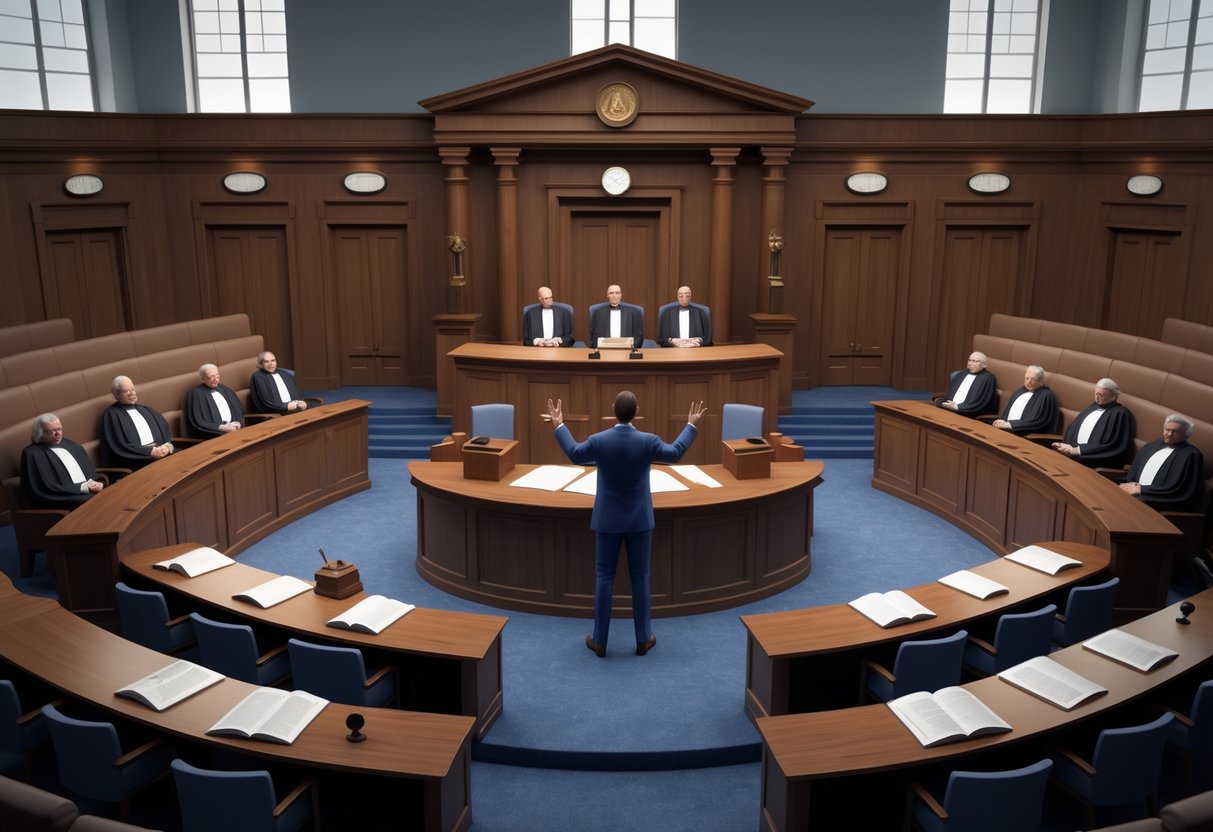
Oral arguments give lawyers a shot to speak directly to the judges. This happens after you file your briefs but before the court makes its decision.
Preparing for Oral Argument
Getting ready for oral argument takes a lot of planning and practice. You need to review all the key facts and legal issues from your case.
Most courts give each side 15 to 30 minutes. That’s not much time, so every word matters.
Focus on your strongest points from the written brief. The judges have already read everything, so don’t just repeat what’s there.
Key steps to prepare:
- Study the case record thoroughly
- Review relevant laws and court decisions
- Practice answers to likely questions
- Prepare clear, simple explanations of complex issues
Judges often ask tough questions. Be ready to answer quickly and honestly. If you don’t know something, admit it—don’t try to fake it.
Mock sessions help you get comfortable speaking in front of others. Ask colleagues to play the judges and challenge you.
Typical Procedures in Oral Hearings
Oral arguments follow a formal structure, though it varies a bit between courts. Usually, three judges sit on the panel.
The appellant’s lawyer goes first, then the appellee’s lawyer. If there are more parties, each gets a turn.
Standard courtroom rules:
- Stand when you address the court
- Call judges “Your Honour” or “My Lord/Lady”
- Wait for permission before speaking
- Stop right away if a judge interrupts
Judges can jump in with questions at any time. These questions show what’s on their minds, so listen closely and answer directly.
Some courts allow a short rebuttal for the appellant’s lawyer at the end. That’s your last chance to respond to new points.
Not every appeal gets oral argument. Sometimes courts decide cases just on the written briefs. If you do get oral argument, it means the judges want to hear more before deciding.
Possible Outcomes of an Appeal

When an appellate court reviews your case, they can affirm the original decision, reverse it, or remand it back to the trial court. Each outcome has different effects on what happens next.
Affirming the Decision
If the appellate court affirms the lower court’s ruling, they agree with the original decision. The court found no big legal errors.
Your conviction and sentence stay the same. The judges decided the trial court applied the law correctly and followed the rules.
An affirmed decision doesn’t mean the trial was perfect. Minor errors might have happened, but they weren’t enough to change the result.
Your options after affirmation:
- Appeal to a higher court, if possible
- Accept the verdict and sentence
- Look into other legal remedies
Most criminal appeals end with affirmation. Appellate courts usually stick with trial court decisions unless something clearly went wrong.
Reversing a Decision
A reversed decision means the appellate court disagrees with the lower court. They found serious mistakes that likely changed the outcome.
Important: A reversal doesn’t mean you’re innocent. The appellate court is saying the trial process was flawed, not ruling on guilt.
Two types of reversals:
Reversal with acquittal happens when there wasn’t enough evidence for conviction. That ends your case, like being found not guilty at trial.
Reversal for retrial occurs when procedural errors affected the trial. The prosecution can choose to retry your case.
After a reversal, prosecutors decide if they want to try again. They might drop the case if they don’t think they can win.
Remanding a Case to Trial Court
Remanding means the appellate court sends your case back to the trial court. The lower court must take specific actions or hold new proceedings.
Common reasons for remand:
- Bad jury instructions
- Wrong evidence rulings
- Sentencing mistakes
- Missed procedural steps
The appellate court gives instructions on what the trial court needs to do. This could mean a new trial or just fixing certain problems.
Remand outcomes can include:
- New trial with different procedures
- Resentencing with corrected rules
- More hearings on specific issues
- Dismissal if the problems can’t be fixed
Most remanded cases end up with new proceedings of some sort. The prosecution still has to prove their case meets legal standards.
Appeal Costs and Financial Considerations

Appeals can rack up a surprising number of expenses, and they add up fast. Most folks end up covering their own legal bills, but sometimes court fees land on the losing side after everything wraps up.
Understanding Court Fees
You’ll face several types of costs during an appeal, so it’s smart to plan your budget early. The filing fee hits first—usually around £600 in federal courts just to get started.
You also have to pay for the trial record, which means all the documents and testimony from your original case. The appellate court needs this stuff to figure out what really happened, and putting it together isn’t cheap.
Attorney’s fees are usually the biggest chunk. Your solicitor charges for digging up legal precedents, drafting briefs, and showing up for oral arguments. Depending on how tricky your case is, these fees can reach thousands of pounds.
Other costs might sneak up on you:
- Printing and copying briefs (courts love paper, apparently)
- Transcript prep fees
- Appeal bonds (if you want to delay paying judgments)
- Random administrative costs
The outcome affects who pays what. Most of the time, each side pays their own lawyer, win or lose. But whoever loses generally gets stuck with court costs like filing and transcript fees.
Options for Fee Waivers
If you just can’t swing the appeal costs, you can ask to proceed in forma pauperis (IFP). This is a legal workaround for folks with limited money who still need to appeal.
You’ll have to file a financial affidavit with the court. In it, you show your income, assets, and monthly bills to prove you can’t afford the fees.
If the court approves, they’ll waive some fees. Usually, this covers things like the filing fee and some court admin costs. You won’t have to pay those right away, which honestly can be a relief.
But there are some catches:
- They don’t cover your solicitor’s fees
- If you lose, you might still owe the other party’s costs
- The waiver only knocks out court fees, not every single expense
Criminal cases work differently. If you’re indigent, the government pays for your first appeal lawyer. That right doesn’t extend to civil cases, though.
After the Appellate Court’s Decision
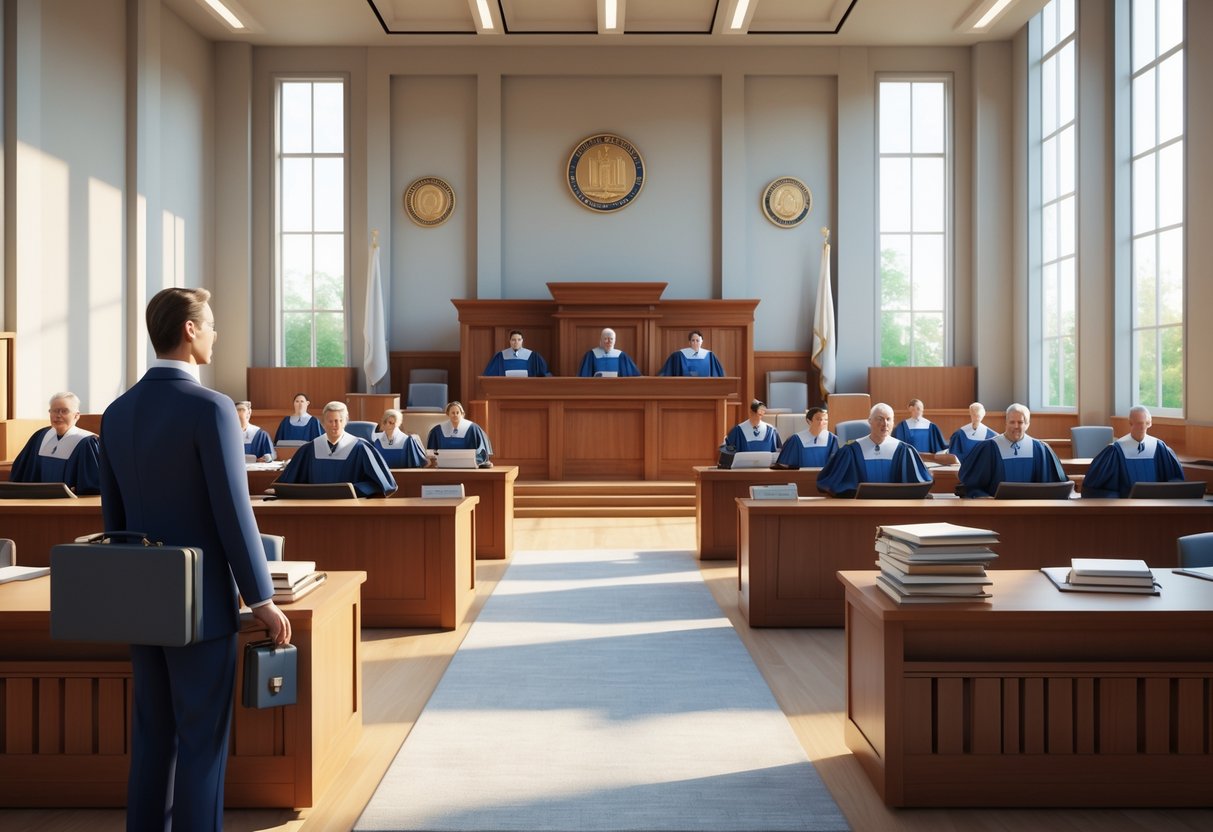
Once the appellate court makes its ruling, the case moves into its last phase. The decision gets put into action, and parties decide if they want to chase another review from a higher court.
Enforcing the Court’s Judgement
The appellate court sends the case back to the trial court using a process called remittitur. That officially ends the appeals court’s part.
The trial court gets legal control again. Now it has to follow the appellate court’s instructions exactly.
Next steps depend on what the appellate court decided:
• Affirmed: The original decision stays as is
• Reversed: The trial court applies the new ruling
• Remanded: A new trial or more proceedings happen
The winning side might need to take steps to collect money or enforce other parts of the judgment. The trial court handles this enforcement.
Sometimes, if the appellate court just confirms the original decision, there’s nothing left to do. Other times, there’s a lot of follow-up.
Options for Further Appeal
Most appellate decisions can go up one more level. You can petition higher courts like state supreme courts or even the US Supreme Court.
But those top courts pick and choose which cases they’ll hear through something called certiorari.
Highest courts usually take cases that:
• Raise major legal questions
• Show lower courts disagreeing
• Affect lots of people or big constitutional issues
If the highest court says no or issues a final decision, that’s the end. No more legal moves through the regular system.
From start to finish, the whole process—from trial court to final appeal—can easily take years.
Frequently Asked Questions

The appeal process has a lot of steps, deadlines, and costs, and all of that changes based on your case and the court. If you know your options, grounds for appeal, and what’s realistic, you’ll feel more prepared to challenge a court’s ruling.
What steps should one take to file an appeal against a judgement?
You have to wait until the court hands down a final decision before you can appeal. There are barely any exceptions.
Figure out which higher court handles your kind of appeal. Lost in District Court? You usually go to Circuit Court. If your case started in Circuit Court, it moves to the Appellate Court.
File your notice of appeal within the deadline the court sets. Miss it, and you lose the right to appeal—no wiggle room.
Pay the filing fees or ask for a waiver if you can’t afford it. The court might also make you pay for preparing transcripts.
Write your brief that lays out the legal mistakes made in the lower court. That’s the backbone of your appeal.
How can one increase their chances of success in a court appeal?
Focus on legal errors, not just disagreeing with the facts. Higher courts care about how the law was used, not whether they’d pick the same facts.
If you can, hire an experienced appeals lawyer. Appeals are tricky and the rules are different from trial court.
Look up similar cases and legal precedents that support your side. Appeals courts lean heavily on what’s already been decided.
Hit every deadline and follow all the court rules. They’re strict about this and can toss your appeal for small mistakes.
Keep your written arguments clear and organized. Avoid getting emotional—stick to where the lower court messed up legally.
What typically occurs following the granting of an appeal?
The higher court reviews your brief and the other side’s response. Most appeals get decided on the written documents, not live testimony.
Sometimes, courts schedule oral arguments. Lawyers present their cases and answer the judges’ questions.
The appellate court might affirm, reverse, or change the lower court’s decision. They could also send it back for more proceedings.
The court writes an opinion explaining what they decided and why. That becomes part of the official record.
If you win, the case might go back to the lower court to follow the appellate court’s orders. If you lose, your options for more appeals are usually pretty limited.
Could you explain the different grounds for lodging an appeal in civil cases?
Legal errors offer the strongest grounds for appeal. Maybe the judge applied the wrong law or misunderstood the legal standard.
Procedural mistakes during your trial can help your appeal. Think improper jury instructions, letting in evidence that shouldn’t be there, or blocking your witnesses.
Abuse of judicial discretion happens when a judge does something no reasonable judge would do. It’s tough to prove, but it can work.
If there wasn’t enough evidence to support the verdict, that’s another ground. You’d need to show that no reasonable person could reach that decision based on what was presented.
Constitutional violations during your case—like due process problems or being denied a lawyer—also count.
Is it possible to appeal any court decision, or are there limitations?
You don’t get to appeal every court decision. Some just aren’t appealable.
Sometimes you need the court’s permission before you can even file an appeal. If they say no, that’s the end.
Most interlocutory orders—decisions made during the case that don’t end it—can’t be appealed. The court has to issue a final judgment first.
Some contracts, like binding arbitration agreements, can block or limit your right to appeal. Always check your paperwork before assuming you can appeal.
Higher courts might refuse to hear a second appeal. Technically, you can try, but they have the power to say no.
Deadlines for appeals are strict. Miss one, and you’re out of luck for good.
What does the appeal procedure entail within the legal system?
You kick things off by filing a notice of appeal with the right higher court. Deadlines for this step can sneak up on you—they really depend on where you’re filing.
Both sides then send in written briefs, laying out their arguments. In your brief, you need to point out exactly where the lower court messed up and why you think the decision deserves another look.
The appellate court digs through the lower court record: transcripts, evidence, legal filings—the whole stack. But they won’t consider new evidence or bring in fresh witnesses.
Sometimes, lawyers get the chance to argue in person and answer the judges’ questions. Other times, the judges just decide everything based on the paperwork.
Eventually, the court hands down a written decision. They might affirm, reverse, tweak, or send the case back to the lower court. Honestly, this whole thing can drag on for months.
If you’re hoping to pause the lower court’s decision while you appeal, you’ll need to file a separate motion to stay. Just filing an appeal doesn’t automatically freeze anything.

